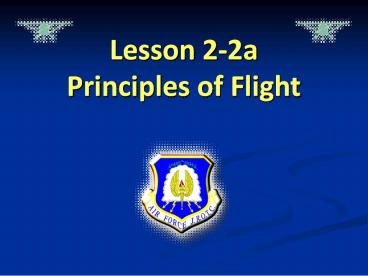Lesson 2-2a Principles of Flight - PowerPoint PPT Presentation
1 / 26
Title: Lesson 2-2a Principles of Flight
1
Lesson 2-2aPrinciples of Flight
2
The Forces of Flight
3
- How many forces are present when an aircraft is
cruising at constant speed and altitude? - a. 0
- b. 2
- c. 4
- d. 6
4
Lift
- Lift is produced almost entirely by moving air
over and under the wings - The profile of a wing is called an airfoil
- Changing the airflow on the surface of the
airfoil (or wing) will increase or decrease the
amount of lift
5
Bernoullis Principle
- Faster airflow causes a decrease in air pressure
- Air flowing over the curved upper surface of a
wing speeds up - Increase in speed reduces pressure above the wing
and produces the upward lifting force
6
Airfoils
- Can be wings or propeller blades
- Parts of airfoil Include leading and trailing
edges, camber and chord line
7
Wind Tunnels, cont.
- The Wright Brothers tested more than 200 wing
shapes in a tunnel before the successful 1902
glider - Researchers can carefully control airflow
conditions and measure the forces on an aircraft
model
8
Activity Bernoullis Principle in Action
- Lets do a quick experiment to demonstrate
Bernoullis Principle in action using a funnel
and a ping-pong ball
9
Effect of Angle of Attack on Flight
- If a plane alters pitchthe up and down movement
of the planes nosethe angle of attack on its
wings will change - As angle of attack increases, wings generate more
lifting force
10
Critical Angle of Attack
- Point at which a plane stallsaround 15
Reproduced from NASA/Glenn Research Center
11
How Lift is Generated
- Air flows over top of wing reducing pressure on
top surface relative to bottom surface of wing - Lift depends on aircrafts shape, size, and
velocity - To increase lift
- Increase aircrafts forward speed
- Increase airfoils angle of attack (up to stall
angle) - Increase surface area of airfoil
Reproduced from NASA/Glenn Research Center
12
Airfoil Camber
- The curve in an airfoil is the camber
- In most airfoils the upper surface curves more
than the lower surface - Airfoils thickness is the maximum distance
between the upper and lower wing surfaces
13
Airfoil Types, Purpose, and Function
- Aircraft weight, speed, and purpose determine
wings shape - Streamlined airfoils dont create enough lift
- Teardrop shaped airfoils have no lift at zero
angle of attack
14
Airfoil Types, Purpose, and Function
- See handout of conventional airfoils
15
The Fuselage
- The fuselage is the aircraft body
- Fuselage vary in shape to fit the mission
- Fuselage must be strong enough to withstand
torque
Courtesy of USAF/CMSgt Gary Emery
16
Wing Position and Parts
- Wing position depends on aircrafts mission
- Main internal parts are spars, ribs and stringers
- Fuel tanks usually part of wing
Reproduced from US Department of
Transportation/Federal Aviation Administration
17
Wing Angles
- Dihedral angles give aircraft roll stability and
level flight - Large commercial airliner wings have dihedral
angles - Fighter aircraft have anhedral angles
Modified from NASA/Glenn Research Center
18
The Role of Stabilizers and Rudders
- Stabilizers are on the aircrafts tail
- Stabilizers keep aircraft stable so it can
maintain straight flight path - Vertical stabilizer prevents the nose of plane
from roving side to size - Horizontal stabilizer keeps plane from bobbing up
and down
19
The Role of Stabilizers and Rudders, cont.
- Rudder is the hinged piece on the vertical
stabilizer - Lets pilot steer the aircraft by moving the tail
left or right - Elevators are the hinged flaps on the horizontal
stabilizer - Lets pilot steer the aircraft by moving the tail
up or down
20
The Positions of Flaps, Spoilers, and Slats on
Aircraft
- Flaps are hinged device at wings trailing edge
that produces lift - Spoiler is small, flat plate that attaches the
tops of wings it increases drag - Slat is moveable, hinged parts that pivot down to
generate more force
21
Primary and Secondary Controls
- Primary Controls make aircraft controllable and
safe to fly - Rudders, elevators, and ailerons
- Secondary controls let the pilot maintain more
control over aircrafts performance - Flaps, slats, and spoilers
22
Primary Flight Controls
- Pilot uses primary flight controls to control
aircraft yaw, pitch, and roll - Rudders control yaw or side-to-side motion of
aircraft - Elevators control pitch or up and down motion of
aircraft - Ailerons control roll or banking of the wings
23
How Ailerons Work
- Aileron is a small hinged section on the outboard
portion of each wing - Ailerons operate in opposite direction on the
wings, causing one to increase lift (point
aileron down), one to decrease lift (point
aileron up)
24
Secondary Flight Controls
- Used primarily in more challenging flight
conditions where low speeds are required
(take-off and landing) - Flaps are on trailing edge of wings and
increase/decrease lift and drag on both wings at
the same time - Slats are on the leading edge of the wings and
also increase/decrease lift and drag on both
wings at the same time - Spoilers reduce lift and increase drag and can
be used on both wings at same time or on one wing
and not the other
25
Spoilers
- Spoilers are small, flat plates that attach to
the tops of the wings with hinges - Raising spoilers on both wings slows aircraft in
any phase of flight - Raising spoilers on only one wing causes a
rolling motion
26
Activity Airplane Parts and Functions
- Label the airplane parts
- Define their function in flight































